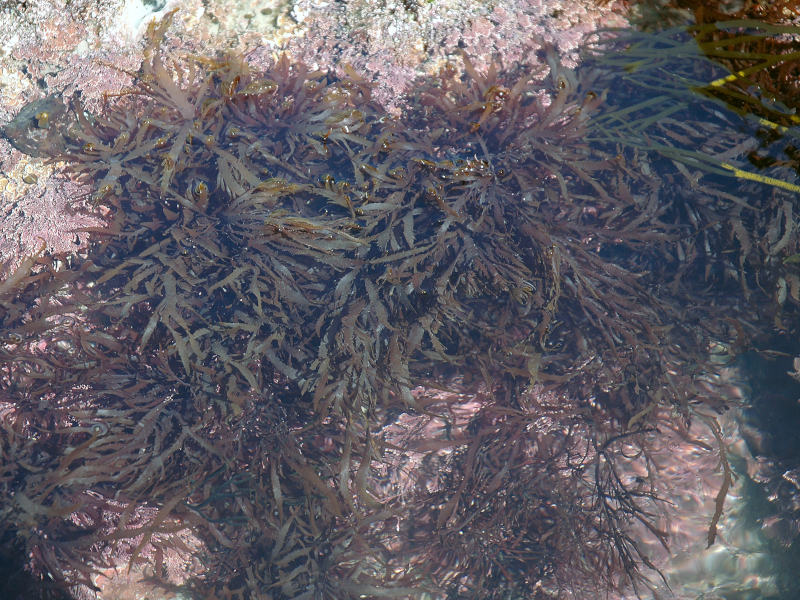Lance-shaped eyelash weed (Calliblepharis jubata)
Distribution data supplied by the Ocean Biodiversity Information System (OBIS). To interrogate UK data visit the NBN Atlas.Map Help
| Researched by | Marisa Sabatini | Refereed by | Admin |
| Authority | (Goodenough & Woodward) Kützing, 1843 | ||
| Other common names | - | Synonyms | Calliblepharis lanceolata (Goodenough & Woodward) Kützing, 1843 |
Summary
Description
Calliblepharis jubata is brownish red in colour. It has a thallus consisting of a branched holdfast that gives rise to an erect frond that expands into a dichotomous or irregularly divided blade. The outline of the frond is variable but it commonly has a cylindrical or very slightly compressed stipe. Its blades are about 6 mm broad and 30 cm long with narrow branches. The branches appear long and tendril like. Long branchlets (proliferations) arise from the blade surface and margins of the branches.
Recorded distribution in Britain and Ireland
Calliblepharis jubata has a predominantly western distribution. It has been recorded on the south and west coasts of England, around the coastline of Ireland, the Isle of Man and the west coast of Scotland.Global distribution
-Habitat
Calliblepharis jubata is epilithic and epiphytic and can grow on other seaweeds, on rocks in pools of the lower eulittoral zone, down into the Laminaria zone. It can also be found in both sheltered and moderately exposed localities and is tolerant of some sand cover.Depth range
-Identifying features
- Tufted brownish red plant.
- Branched holdfast.
- Lanceolate shaped lobes.
- Long branchlets (proliferations) up to 3 cm in length that are sometimes hooked or coiled at the tips.
Additional information
Calliblepharis jubata is a gametangial plant with male and female reproductive organs (dioecious). The male reproductive structures (spermatangia) have been recorded in the British Isles but not described. The female reproductive structures (cystocarps) are 1-2 mm in diameter and become visible around April forming prominent globose structures on the branchlets. The asexual reproductive structures (tetrasporangia) that are rarely recorded but are known to appear for April, June and July. These are found on the branchlets, though they may sometimes occur sparingly on the blades. The tetrasporangia develop in the cortex with zonately arranged tetraspores but no further information is available.
The blades of Calliblepharis jubata may vary in width and the degree of subdivision. In Cornwall and the Isles of Scilly specimens occur that are unlike the normally accepted appearance, these have particularly broad fronds up to 15 mm long (Dixon & Irvine, 1977). Calliblepharis jubata is very similar to Calliblepharis ciliata. However, the latter has smaller branchlets (5 mm) and a wider frond. Calliblepharis jubata matures in summer, with the appearance of cystoscarps and spermatangia. Calliblepharis ciliata mature throughout the winter (Dixon & Irvine, 1977).
Specimens of Calliblepharis jubata with narrow blades may also be confused with Gigartina acicularis. However, Gigartina acicularis is a rigid plant that reaches maturity in winter, while Calliblepharis jubata is not rigid. Very young Calliblepharis jubata may also resemble Gelidium spp. However, the cortical cells of Calliblepharis jubata are much larger (7-15 µm) although microscopic examination is required to differentiate between them (Dixon & Irvine, 1977).
Listed by
- none -
Bibliography
Bunker, F., Perrins, J., Maggs, C.A. & Bunker, A., 2003. British Isles Seaweed Images. [On-line] http://www.weedseen.co.uk/, 2004-01-23
Dickinson, C.I., 1963. British seaweeds. London & Frome: Butler & Tanner Ltd.
Dixon, P.S. & Irvine, L.M., 1977. Seaweeds of the British Isles. Volume 1 Rhodophyta. Part 1 Introduction, Nemaliales, Gigartinales. London: British Museum (Natural History) London.
Hardy, F.G. & Guiry, M.D., 2003. A check-list and atlas of the seaweeds of Britain and Ireland. London: British Phycological Society
Hiscock, S., 1986b. A field key to the British Red Seaweeds. Taunton: Field Studies Council. [Occasional Publication No.13]
Howson, C.M. & Picton, B.E., 1997. The species directory of the marine fauna and flora of the British Isles and surrounding seas. Belfast: Ulster Museum. [Ulster Museum publication, no. 276.]
Datasets
Cofnod – North Wales Environmental Information Service, 2018. Miscellaneous records held on the Cofnod database. Occurrence dataset: https://doi.org/10.15468/hcgqsi accessed via GBIF.org on 2018-09-25.
Fenwick, 2018. Aphotomarine. Occurrence dataset http://www.aphotomarine.com/index.html Accessed via NBNAtlas.org on 2018-10-01
Kent Wildlife Trust, 2018. Kent Wildlife Trust Shoresearch Intertidal Survey 2004 onwards. Occurrence dataset: https://www.kentwildlifetrust.org.uk/ accessed via NBNAtlas.org on 2018-10-01.
Manx Biological Recording Partnership, 2017. Isle of Man wildlife records from 01/01/2000 to 13/02/2017. Occurrence dataset: https://doi.org/10.15468/mopwow accessed via GBIF.org on 2018-10-01.
Manx Biological Recording Partnership, 2018. Isle of Man historical wildlife records 1995 to 1999. Occurrence dataset: https://doi.org/10.15468/lo2tge accessed via GBIF.org on 2018-10-01.
NBN (National Biodiversity Network) Atlas. Available from: https://www.nbnatlas.org.
OBIS (Ocean Biodiversity Information System), 2025. Global map of species distribution using gridded data. Available from: Ocean Biogeographic Information System. www.iobis.org. Accessed: 2025-08-08
Royal Botanic Garden Edinburgh, 2018. Royal Botanic Garden Edinburgh Herbarium (E). Occurrence dataset: https://doi.org/10.15468/ypoair accessed via GBIF.org on 2018-10-02.
South East Wales Biodiversity Records Centre, 2018. SEWBReC Algae and allied species (South East Wales). Occurrence dataset: https://doi.org/10.15468/55albd accessed via GBIF.org on 2018-10-02.
Citation
This review can be cited as:
Last Updated: 09/11/2006




